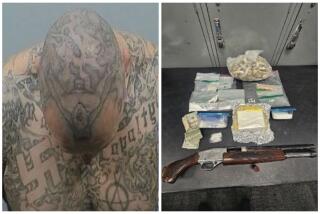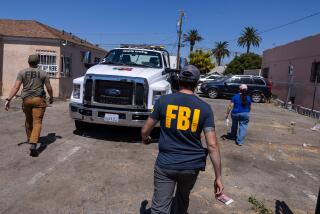Study Cites Menace of Drug-Crime Networks
Violent narcotics dealers such as the Colombian cocaine network and various gangs composed of street hoodlums, prison inmates, outlaw motorcyclists and Asian criminals pose a growing threat in California--and one that is far more menacing than the traditional Mafia network, state Atty. Gen. John Van de Kamp said Tuesday.
The attorney general’s annual report on organized crime, which he is required by state law to prepare, also warned that these non-traditional groups, which dominate the state’s thriving narcotics trade, appear to be getting better organized.
One “especially disturbing” trend shows greater linkage between street gangs and prison gangs, including the emergence of one new prison group--the Consolidated Crips Organization, organized by and composed largely of incarcerated members of Los Angeles’ notorious “Crips” street gang.
The wide-ranging report, prepared by the attorney general’s Bureau of Organized Crime and Criminal Intelligence (BOCCI), also identified the Jewish Defense League as being among the “most active terrorist groups in California.” Officials said that description was based on assertions by the FBI that the JDL “might be responsible for the bombing” in Santa Ana last October that killed Alex Odeh, regional director of the American-Arab Anti-Discrimination Committee.
Anti-Drug Bills Endorsed
In a Los Angeles press conference, Van de Kamp endorsed several bills designed to combat the drug trade, particularly by giving law enforcement agencies great latitude in using electronic surveillance equipment and strengthening penalties against money-laundering.
If the Legislature does not toughen these laws, he said, “we could easily join Prohibition-era Chicago and Miami in the early ‘80s as notorious examples of communities overwhelmed by organized crime.”
Van de Kamp sought to emphasize that “the public perception of organized crime is dominated by images from the past,” by movies like “The Godfather” and gangsters like Al Capone and John Dillinger.
“But this is the ‘80s. Today’s big money is in smuggling cocaine. . . . Today’s most murderous hit men execute their contracts from California prisons, not Chicago speak-easies. . . . And the new godfathers are more likely to come from Colombia than Calabria.”
Top Criminal Enterprise
The trafficking of illegal narcotics remains the nation’s biggest criminal enterprise, with California “rapidly overtaking Florida as the national center of the drug trade,” Van de Kamp said.
The BOCCI report stressed that “non-traditional organized crime groups . . . are responsible for the vast majority of large-scale narcotics trafficking in California. . . . Compared to other groups, traditional organized crime’s narcotics involvement is minimal.”
By contrast, traditional Mafia groups, like the Southern California crime family and representatives of East Coast crime families, are more active in such enterprises as pornography, bookmaking and high-stakes bingo games.
As in previous reports, the attorney general identified Peter John Milano, a Westlake Village resident and chief executive officer of a vending machine business, Rome Vending Inc., as the head of the Southern California crime family. Another leading figure in the group, Michael Rizzitello, is to be released from prison later this year.
The non-traditional groups specialize in different aspects of the drug trade, Van De Kamp said. Motorcycle gangs like the Hell’s Angels operate most of the crystal methamphetamine labs in rural areas, while cocaine smuggling is dominated by the Colombian crime families, such as the Ochoa organization.
“These are violent, close-knit operations with almost unlimited funds,” Van de Kamp said. “Indeed, one of their few major problems is laundering all the cash they rake in.”
New Types of Networks
Meanwhile, the “rock” cocaine business practiced largely by black street gangs in Los Angeles “may also be creating new and lethal types of organized crime networks,” he said. Los Angeles police have attributed a recent jump in youth gang violence to “turf” struggles in the narcotics trade.
Such developments, Van de Kamp said, compound the threat of the Consolidated Crips Organization (CCO) and other prison gangs with links to street gangs. The Crips organization is said to be unique in that it has direct, continuing links with the many Crips-affiliated gangs of South-Central Los Angeles.
The organization “has emerged to challenge the big four--the Black Guerrilla Family, the Mexican Mafia, the Aryan Brotherhood and the Nuestra Familia,” the attorney general said.
In an interview, Louie Dentici, chief of the Department of Corrections unit that monitors prison gang activity both inside and outside the institutions, said that assessment of the CCO was “semi-accurate.” It is also possible that the CCO may merge with the Black Guerilla Family, he said.
The black prison gangs, Dentici says, “can’t get their act together. That’s a godsend for us, believe me.”
The sheer numbers of incarcerated Crips--about 200 in San Quentin alone, for example--present the potential of a powerful group. However, “you have a whole bunch of different types of Crips and many can’t get along with each other,” Dentici said.
He agreed that prison gang activity involving parolees and their associates is growing substantially, especially in Los Angeles, he said. “They’re getting younger kids to do their dirty work for them. . . . Like they’ll get some other little street gang to do burglaries, then they’ll get the stuff, fence it off and give the street gang a fee.”
The BOCCI report further noted that the number of homicides--both inside and outside penal institutions--that have been linked to prison gangs increased from 14 in 1984 to 25 in 1985, reversing a seven-year downward trend. Of the 25 slayings, 16 occurred inside prisons and nine occurred on the outside.
Motorcycle Gangs
The white-supremacist Aryan Brotherhood, which law enforcement authorities say has some links with motorcycle gangs, was responsible for “a major share” of these killings--a status that in previous years was held by the Mexican Mafia or the Nuestra Familia.
Asian gangs--some with domestic roots and some associated with Asian-based international crime syndicates--also appear to be expanding operations in California, the report said.
The Japanese Yakuza, the Taiwan-based United Bamboo Organized Crime Syndicate and Chinese “triads”--secret criminal societies dating to the 17th Century--are involved in narcotics trafficking, extortion, prostitution, gambling and money-laundering.
The Yakuza, for example, also run guns from California to Japan, where firearms are prohibited, the report said.
Animal Liberation
The report asserted that although terrorist activity worldwide has increased dramatically in 1985, there were relatively few incidents in California. The report identified the Jewish Defense League, the White American Bastion and the Animal Liberation Front as “the most active terrorist groups in California” during the past year.
In a carefully worded section, the report noted that “according to media reports, federal authorities believed that the JDL might be responsible for the bombing” that killed Odeh. No arrest has been made in the fatal attack.
Elaborating on the report, Jerry Marynik, chief of the attorney general’s anti-terrorism section, said the statement was not only based on media reports, but also on direct assertions from the FBI that the JDL was responsible for the murder. More recently, the FBI has since backed away from such assertions.
“All of a sudden they have backed off--I don’t know why,” Marynik said. “At first they were fairly confident it was the JDL. I suspect they still believe that, but because of the lack of arrests they may have some hesitancy.”
Law enforcement authorities, the report said, also believe the JDL is responsible for a second “terrorist attack” in California. After a Northridge resident publicly claimed that the Nazis did not kill millions of Jews, his home was bombed and painted with the letters “JDL.”
Members of the white supremacist White American Bastion, a small extremist group with the stated goal of overthrowing the U.S. government in a race war, were believed responsible for murder, counterfeiting, arson and possession of illegal weapons throughout the Western states. The group committed the July, 1984, robbery of a Brinks armored car near Ukiah, in which more than $3 million was stolen.
In April, 1985, 23 members of the groups were indicted on racketeering charges in Seattle. Among those who pleaded guilty or were convicted were three Californians--Frank Silva, Richard Kemp and Randall Evans.
The Animal Liberation Front, a group dedicated to eradicating experimental research on animals, was blamed for several acts of vandalism and bogus bomb threats. An attack on a research lab in Riverside caused an estimated $700,000 in damages, the report said. The group claimed credit for causing the evacuation of two San Diego department stores that sold animal furs by placing simulated bombs in restrooms.
More to Read
Sign up for Essential California
The most important California stories and recommendations in your inbox every morning.
You may occasionally receive promotional content from the Los Angeles Times.









